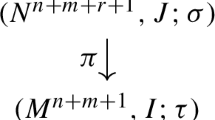Abstract
The external description of a system [A,B,C,D] is given by its transfer function W(λ). Classically in designing a system with given transfer function the key step is to express W(λ) as a linear functional combination of simpler functions. Naturally such a decomposition of a transfer function must correspond to some type of decomposition of the system [A,B,C,D] into smaller subsystems. In this article we describe the correspondence precisely. It leads us to define a reducing pair of subspaces S1 ⊕ S2 for a system with state space X to be a pair which gives a direct sum decomposition X = S1 ⊕ S2 for X such that S1 is (A,B) invariant and S2 is (C,A) invariant. It turns out that each reducing pair for a system gives rise to a small family of linear fractional decompositions of the transfer function. Conversely, any non-trivial "minimal" decomposition of the transfer function of a minimal system corresponds to a reducing pair for that system.
Similar content being viewed by others
References
J. A. Ball and J. W. Helton, The decomposition of a system which corresponds to classical circuit synthesis procedures, Systems and Control Letters, to appear.
H. Bart, I. Gohberg and M. A. Kaashoek. Minimal Factorization of Matrix and Operator Functions, Birkhauser, 1979.
L. deBranges and J. Rovnyak, Canonical Models in Quantum Scattering Theory, Perturbation Theory and its Application in Quantum Mechanics, Wiley, 1966.
M. S. Brodskii, Triangular and Jordan représentations of linear operators, Transl. of Math Monographs, vol. 32, Amer. Math. Soc. (1971).
V. M. Brodskii, I. C. Gohberg, and M. G. Krein, "On characteristic functions of an invertible operator,"Acta. Sci. Math., Szeged), 32 (1971), 141–164.
C. Davis, "J-unitary dilation of a general operator,"Acta. Sci. Math. (Szeged) 31 (1970), 75–86.
C. Davis and C. Foias, "Operators with bounded characteristic function and their J-unitary dilation,"Acta. Sci. Math. (Szeged), 32 (1971), 127–139.
P. Fuhrmann, Linear Systems and Operators in Hilbert Space, McGraw-Hill, 1981.
I. Gohberg, M. A. Kaashoek and F. van Schagen, "Similarity of operator blocks and canonical forms I. General results, feedback equivalence and Kronecker indices,"Integral Equations and Operator Theory, 3 (1980), 350–396.
M. S. Livsic and A. A. Yantsevich, Operator Colligations in Hilbert Spaces (translated by the Amer. Math. Soc.), Winston, 1979.
B. Sz.-Nagy and C. Foias, Harmonic Analysis of Operators on Hilbert Space, North Holland/American Elsevier, 1970.
L. Sachnovich, "On the factorization of an operator-valued transfer function,"Sov. Math. Dokl., 226 (1976), 203–207.
W. M. Wonham, Linear Multivariable Control: a Geometric Approach, Springer-Verlag, 1979.
J. W. Helton, Discrete systems, operator models and scattering theory, J. Funt. Anal. 16 (1974), 15–38.
Author information
Authors and Affiliations
Additional information
This work was partially supported by the National Science Foundation.
Rights and permissions
About this article
Cite this article
Helton, J.W., Ball, J.A. The cascade decompositions of a given system vs the linear fractional decompositions of its transfer function. Integr equ oper theory 5, 341–385 (1982). https://doi.org/10.1007/BF01694044
Received:
Issue Date:
DOI: https://doi.org/10.1007/BF01694044




